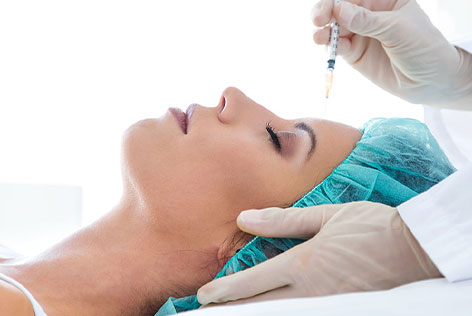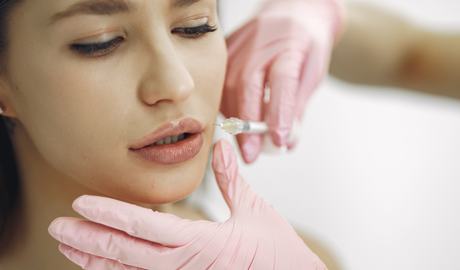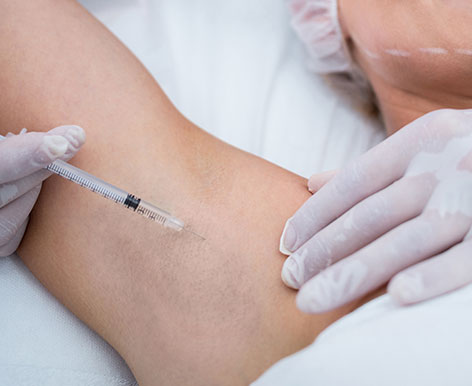Medical Treatments
Botox For Migraines
Botox has been approved in Canada for migraine treatment and prevention since 2011.
It is an extremely effective treatment for migraine with minimal downtime. Most patients experience a significant reduction in migraine frequency and severity for 4 months or longer after botox treatment.
The procedure only takes about 15 minutes.

How does it work? BOTOX® blocks chemical changes on nerve endings. To treat chronic migraine, BOTOX® is injected into muscles of the forehead, the side and back of the head, and the neck and shoulders to produce a partial and temporary chemical “denervation” of the muscles. Botox is thought to reduce neurogenic inflammation which is one of the a key components of migraine activation.
Most extended insurance plans partially cover the cost of botox for migraines.
Botox For Migraines
Botox has been approved in Canada for migraine treatment and prevention since 2011.
It is an extremely effective treatment for migraine with minimal downtime. Most patients experience a significant reduction in migraine frequency and severity for 4 months or longer after botox treatment.
The procedure only takes about 15 minutes.

How does it work? BOTOX® blocks chemical changes on nerve endings. To treat chronic migraine, BOTOX® is injected into muscles of the forehead, the side and back of the head, and the neck and shoulders to produce a partial and temporary chemical “denervation” of the muscles. Botox is thought to reduce neurogenic inflammation which is one of the a key components of migraine activation.
Most extended insurance plans partially cover the cost of botox for migraines.

TMJ Treatment
The temporomandibular joint is the joint that connects your jaw to your skull. When this joint is injured or damaged, it can lead to a localized pain disorder called temporomandibular joint (TMJ) syndrome or temporomandibular disorder (TMD).
Causes of TMJ disorders include injury to the teeth or jaw, misalignment of the teeth or jaw, teeth grinding or clenching, poor posture, stress, arthritis, and gum chewing.
TMJ disorders often respond to home remedies, including ice packs to the joint, over-the-counter non-steroidal anti-inflammatory drugs (NSAIDs), avoiding chewing gum, massage or gentle stretches of the jaw and neck, and stress reduction.
When home treatment does not work, medical treatment for temporomandibular joint (TMJ) syndrome includes dental splints, Botox injections, physical therapy, prescription medications, and in severe cases, surgery.

TMJ Treatment
The temporomandibular joint is the joint that connects your jaw to your skull. When this joint is injured or damaged, it can lead to a localized pain disorder called temporomandibular joint (TMJ) syndrome or temporomandibular disorder (TMD).
Causes of TMJ disorders include injury to the teeth or jaw, misalignment of the teeth or jaw, teeth grinding or clenching, poor posture, stress, arthritis, and gum chewing.
TMJ disorders often respond to home remedies, including ice packs to the joint, over-the-counter non-steroidal anti-inflammatory drugs (NSAIDs), avoiding chewing gum, massage or gentle stretches of the jaw and neck, and stress reduction.
When home treatment does not work, medical treatment for temporomandibular joint (TMJ) syndrome includes dental splints, Botox injections, physical therapy, prescription medications, and in severe cases, surgery.
Botox For Excessive Sweating
The procedure is a 15 minute, no downtime procedure. Most patients get significant reduction or even elimination of their excessive underarm sweating and the results can last 3 to 9 months.
How does it work? Botox stops sweat in the area where it is placed by blocking the release of acetylcholine (Acetylcholine is responsible for activating the sweat gland) and when acetylcholine is blocked the sweat gland becomes inactive.

For most people, this therapy is a delightful change, liberating them from daily worries of sweating in the wrong place at the wrong time.
Most extended insurance plans cover a portion of the cost of Botox for Excessive Sweating.
Botox For Excessive Sweating
The procedure is a 15 minute, no downtime procedure. Most patients get significant reduction or even elimination of their excessive underarm sweating and the results can last 3 to 9 months.
How does it work?

Botox stops sweat in the area where it is placed by blocking the release of acetylcholine (Acetylcholine is responsible for activating the sweat gland) and when acetylcholine is blocked the sweat gland becomes inactive.
For most people, this therapy is a delightful change, liberating them from daily worries of sweating in the wrong place at the wrong time.
Most extended insurance plans cover a portion of the cost of Botox for Excessive Sweating.
